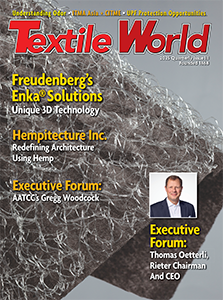RESEARCH TRIANGLE PARK, N.C. — February 3, 2016 — AATCC’s 2016 International Conference is a “must attend” event, with a pre-conference functional finishing tutorial and presentations featuring industry leaders, plus opportunities to build and expand your professional network.
A major industry event, the 2016 IC, will be held April 19-21 in Williamsburg, Virginia, USA, and features a keynote presentation, educational tracks, a poster session, the Herman and Myrtle Goldstein Student Paper Competition, networking receptions, and the Awards Luncheon, where AATCC’s most prestigious awards will be presented.
Keith Hoover, Vice President of Material Process & Color Innovation, Under Armour, will provide the keynote presentation entitled “Made Here, Made Possible – Building a Local-for-Local Apparel Manufacturing Model”.
Three concurrent educational tracks reflect the Association’s three Interest Groups:
- Concept 2 Consumer® (C2C)
Sessions in the C2C track will focus on comfort & performance insight; global impact: concept to consumer; product research & development; print & technology; and color management & LED lighting update.
- Chemical Applications
The Chemical Applications track will address sustainable applications, advances in wet processing, innovative technologies, and also include the Herman and Myrtle Goldstein Student Paper Competition.
- Materials
Presentations in the Materials track will include protective textiles, functional textiles, and materials analyses/bio-based materials.
Tabletop exhibits and sponsorship opportunities are available to promote a company’s presence at this event. The sponsorships include sponsoring a morning break, carving station, Welcoming Reception, educational track, exit drawing giveaway and more.
The conference, which will be held at the Williamsburg Lodge in Williamsburg, is open to anyone who would like to attend.
Posted February 9, 2016
Source: AATCC




